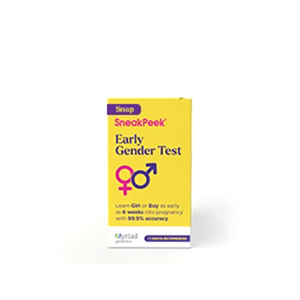Published on June 6th, 2022 and Updated on April 19th, 2024
Check out SneakPeek Gender Test to find out your baby’s gender as early as 6 weeks at over 99% accuracy1!
If you’re eager to conceive, you might think about taking a pregnancy test right after ovulation. However, it’s generally more accurate to wait until after you’ve missed your period. Waiting at least 2 weeks after your fertile window is often enough, depending on your menstrual cycle length.
How do pregnancy tests work?
Home pregnancy tests are designed to detect one hormone associated with pregnancy: human chorionic gonadotropin (hCG).
After a sperm fertilizes an egg, the cells begin to multiply, becoming what’s known as a blastocyst (which will later become your embryo). The outer cells of the blastocyst, known as the trophoblast, generate hCG during this early stage of pregnancy. Eventually, the trophoblast will also form the placenta, the organ that develops during pregnancy to deliver oxygen and nutrients to your growing baby.
The generation of hCG is crucial to the progression of your pregnancy because it signals your body to set off a cascade of changes:
- First, hCG communicates with the corpus luteum—the husk of your egg’s sac inside your ovary. When fertilization occurs, the corpus luteum receives signals from hCG emissions to transform into a temporary endocrinal gland.
- The corpus luteum, the temporary endocrinal gland, begins producing progesterone. Progesterone is responsible for:
- Promoting blood flow and oxygen to the uterus.
- Enabling the uterus to expand without causing tissue spasms.
- Thickening and enriching your uterine lining to prepare for your embryo’s implantation.
When you first become pregnant, hCG levels skyrocket to prepare your body for its new tenant. Levels then double every 2 to 3 days and peak around 6 weeks after your missed period.
So how soon will a pregnancy test read positive?
In an average 28-day cycle, the best period (no pun intended!) to take a pregnancy test is at least 12 to 15 days after ovulation. This ensures there’s enough hCG after ovulation for accurate detection.
How is hCG detected?
There are two methods for hCG detection:
- Blood tests – Blood pregnancy tests can detect hCG in as little as 6 to 8 days after ovulation. These tests are performed by medical professionals, and they may be more accurate at verifying a pregnancy than their over-the-counter competitors because they can detect smaller levels of hCG. In fact, blood tests not only detect hCG, but they also measure the exact amount of hCG in your blood to provide information like if you’re experiencing a molar pregnancy-not ectopic pregnancy or your probability of having twins.
- Urine tests – Urine pregnancy tests can be bought over-the-counter and taken 12 to 15 days after ovulation. In contrast to blood pregnancy tests, these store-bought tests work strictly as hCG detectors to screen for the earliest sign of a possible pregnancy (rather than measuring exact hCG levels). While they’re not as sensitive as blood tests, they’re comparatively more affordable and accessible.
If you’re itching to start a family and suspect you might be expecting, your first instinct may be to march over to your local drugstore, purchase an at-home test kit, and brace yourself for the results in your bathroom.
There are two considerations to keep in mind when you take an at-home pregnancy test: false negatives and false positives.
What causes false results on pregnancy tests?
While it can be disheartening to get a negative pregnancy test, you should still be wary when you get a positive result.
When you take an at-home pregnancy test in the recommended timeframe, most tests boast a 99% accuracy rate at detecting hCG.
That said, it’s not out of the question for urine tests to yield inaccuracies. While false negatives indicate you are not pregnant (even if you are), false positives indicate you are pregnant (even if you aren’t).
Though these inaccuracies can be frustrating, it can be helpful to familiarize yourself with the reasons they may occur. Common reasons for false negatives include:
- Irregular periods – Many women experience a degree of variability in their menstrual rhythms. If your period isn’t known to be particularly punctual, you may have miscalculated your ovulation dates and taken a pregnancy test prematurely.
- Watery urine – HCG is processed by your kidneys and exits your body through your urine stream. This means test accuracy is highly contingent on your hydration levels. If your urine contains large amounts of water, your at-home test may struggle to register hCG in trace amounts. For this reason, the best time of day to take a pregnancy test is in the morning, when hCG levels will be most concentrated.
- Using a test that is not sensitive enough – Opting for a test that is not sensitive enough to detect lower levels of hCG might lead to false negatives, even if you are pregnant. When choosing a test, ensure it’s designed to detect low levels of hCG to receive reliable results as early as possible.
- Not testing urine immediately – If you wait too long to read the test results after the recommended window, you might encounter a false positive or false negative. It’s important to follow the instructions provided.
Common reasons for false positives include:
- Fertility medications – If you’re receiving a course of fertility treatment, the medications you’re taking are likely to mess with the results of your at-home pregnancy test. This is because IVF and IUI drugs use synthetic forms of hCG to prime your body for pregnancy, ultimately registering in urine tests and resulting in a false positive reading.
- Lost pregnancy – It’s rare, but sometimes false positives can occur if an egg becomes fertilized but doesn’t successfully implant into the uterine wall or is genetically not compatible with life. This is also known as a chemical pregnancy. Since the body begins producing hCG before implantation (and implantation can occur anywhere from 6 to 12 days after ovulation), a urine test may detect hCG even if the egg fails to implant or is not genetically sustainable.
- Ectopic pregnancy – Ectopic pregnancies occur when a fertilized egg is implanted outside of the uterus (usually in the fallopian tube). Although not technically a false positive, it does signal the occurrence of an unviable pregnancy which much be treated immediately to ensure your health and safety. If you suspect you might be pregnant but experience sharp cramping, bleeding, or dizziness, contact your healthcare provider immediately to rule out an ectopic pregnancy.
- Perimenopause – Perimenopausal individuals may experience slightly elevated levels of circulating hCG, even without pregnancy. This can potentially lead to a false positive outcome on a pregnancy test.
When To Contact A Doctor
If you suspect you might be pregnant or have received a positive result on a home pregnancy test, it’s a good idea to contact a healthcare provider. While at-home pregnancy tests are generally accurate, a healthcare professional can offer confirmation, answer your questions, and provide guidance on the next steps. Additionally, if you experience any unusual symptoms or concerns, such as severe abdominal pain, heavy bleeding, or dizziness, it’s important to seek medical attention promptly.
How To Pinpoint Your Fertile Window
When it comes to all things pregnancy, timing is everything. Not only does your pregnancy test’s accuracy hinge on when you take it, but your chances of conception in the first place depend on an accurate calculation of your ovulation date.
Most women with regular 28 day cycles are at their most fertile 16 to 18 days before they get their period. However, if your cycles don’t always go by the book, you may have to pull out some extra stops to determine your fertile window—the period during and after ovulation when you’re most likely to get pregnant.
There are two tried-and-true ways to ascertain when ovulation occurs: ovulation tests and the fertility awareness method.
Aside from monitoring your fertility window, you can also check signs of high fertility in a woman, which include an increase in body temperature, breast sensitivity, etc.
What is an ovulation test?
While pregnancy tests are designed to detect hCG, at-home ovulation tests look for luteinizing hormone (LH) in your urine.
LH is the hormone that encourages the growth of your egg throughout its life cycle. In the hours before it’s released from your ovaries, these hormones reach a fever pitch, signaling to your ovary that it’s time to release the egg into the fallopian tube for potential fertilization.
Most ovulation test kits contain 5 to 7 tests so that you can test for LH each day leading up to your suspected ovulation date. When used consistently, ovulation tests can be an excellent method for painting a picture of your monthly cycles.
What is the fertility awareness method?
The fertility awareness method can help you gauge your ovulatory cycles by paying attention to signs that indicate your body is preparing for a possible pregnancy instead of testing for hormones in your urine.
There are 3 main signals your body gives to indicate you’re approaching your fertile window:
- Basal body temperature (BBT) – Basal body temperature refers to the baseline temperature of your body at rest (i.e., while you’re catching some Zzs). Right before your egg is released from its hatch, your temperature dips temporarily. Then, when your egg is traveling toward the uterus, your temperature peaks and stays slightly elevated for the duration of ovulation. By tracking your BBT consistently, you can pinpoint exactly when you ovulate each month.
- Cervical positioning – Right before ovulation occurs, the cervix softens, opens slightly, and retreats higher up into your body to clear the way for fertilization to occur. If you’re up for it, you can observe these changes firsthand with a self-examination.
- Cervical discharge – Approaching ovulation, your cervical mucus becomes creamy in texture. But, when ovulation occurs, it becomes moist and viscous—one way your uterus creates a more hospitable environment for sperm to enter and glide swiftly to meet your egg.
Paying attention to one or all three of these signals undoubtedly requires some extra vigilance (and, in the case of cervical positioning, a hands-on approach). However, when used consistently, this method can offer up to 99% accuracy for predicting ovulation windows.
Common FAQs about Pregnancy Tests
When is the best time to take a pregnancy test?
The best time of day to take a pregnancy test is typically in the morning, as the concentration of the pregnancy hormone hCG (human chorionic gonadotropin) is usually highest in the first urine of the day. This concentrated urine can provide more accurate results.
What are the signs that you should take a pregnancy test?
Signs that indicate you might consider taking a pregnancy test include missed periods, breast tenderness, fatigue, increased urination, changes in appetite or food aversions, heightened sense of smell, and light spotting or implantation bleeding. If you’ve had unprotected sex and are experiencing any of these symptoms, it’s a good idea to take a pregnancy test a few days before your expected period.
What should I do after I get a positive pregnancy test?
Congratulations on your positive pregnancy test! After receiving a positive result, it’s important to schedule an appointment with a healthcare provider. They will confirm the pregnancy and provide guidance on prenatal care, medical tests, and lifestyle adjustments.
Feeling Impatient? Look Ahead in Your Pregnancy With SneakPeek
Playing the waiting game isn’t easy when you dream of becoming a parent to a brand-new bundle of joy. But while waiting, you can also try other unconventional methods to boost fertility, like fertility yoga. Meanwhile, figuring out how to increase your chances of twins is another ball game.
Fortunately, there’s plenty of baby-related news you won’t have to wait around for once you successfully conceive. The SneakPeek At-Home Early Gender Prediction Test is the only test that can predict the sex of your baby as early as 6 weeks into your pregnancy (3 months sooner than with an anatomy scan ultrasound) and with over 99% clinically proven accuracy1. In fact, we’re so sure of our accuracy, we provide a full refund if your results don’t match your baby’s sex.
The #1 OBGYN-recommended DNA-based at-home gender blood test, SneakPeek has given over 1 million moms the gift of incredible knowledge and privacy-protected results.
Once you confirm your pregnancy, get to know your little miracle sooner than ever before with SneakPeek test.
This post has been reviewed for accuracy by the following medical professional:
Dr. Heather Soper, Certified Nurse Midwife
Dr. Heather Soper brings over 15 years of experience in women's health and obstetrics to her role as the owner of The Genesis Resort for Birth. Complementing her clinical practice, she serves as an Assistant Professor of Nursing at James Madison University, where she educates nursing students with a focus on compassionate, patient-centered care. Her advanced training and dedication to midwifery are evident in her contribution to both academia and the wellness of expectant mothers
Sources:
- Medical News Today. What is a corpus luteum? https://www.medicalnewstoday.com/articles/320433#what-is-the-corpus-luteum
- American Pregnancy Association. What is HCG? https://americanpregnancy.org/getting-pregnant/hcg-levels/
- Endocrine Society. Brain Hormones. https://www.endocrine.org/patient-engagement/endocrine-library/hormones-and-endocrine-function/brain-hormones
- VeryWell Family. What Is a Blood Pregnancy Test and How Does It Work? https://www.verywellfamily.com/what-is-a-blood-pregnancy-test-2759849
- Mayo Clinic. Home pregnancy tests: Can you trust the results? https://www.mayoclinic.org/healthy-lifestyle/getting-pregnant/in-depth/home-pregnancy-tests/art-20047940
- National Library of Medicine. Human Chorionic Gonadotropin. https://www.ncbi.nlm.nih.gov/books/NBK532950/
- Healthline. 7 Causes for a False-Positive Pregnancy Test. https://www.healthline.com/health/pregnancy/false-positive-pregnancy-test#ectopic-pregnancy
- University of Michigan Health. Basal Body Temperature (BBT) Charting. https://www.uofmhealth.org/health-library/hw202058
- Healthline. Cervix Before Period: How to Identify Changes Throughout Your Menstrual Cycle. https://www.healthline.com/health/cervix-before-period
- National Health Service. Natural family planning (fertility awareness) – Your contraception guide. https://www.nhs.uk/conditions/contraception/natural-family-planning/
- FDA. Pregnancy.
- https://www.fda.gov/medical-devices/home-use-tests/pregnancy#:~:text=hCG%20is%20a%20hormone%20produced,12%2D15%20days%20after%20ovulation.
- U.S. Department of Health & Human Services. Knowing if you are pregnant. https://www.womenshealth.gov/pregnancy/you-get-pregnant/knowing-if-you-are-pregnant#:~:text=They%20can%20pick%20up%20hCG,of%20hCG%20in%20your%20blood.

Shop Our Products
SneakPeek aims to provide the most accurate and up-to-date information to help our readers make informed decisions regarding their health before, during, and after pregnancy. This article was written based upon trusted scientific research studies and/or articles. Credible information sources for this article are cited and hyperlinked.






